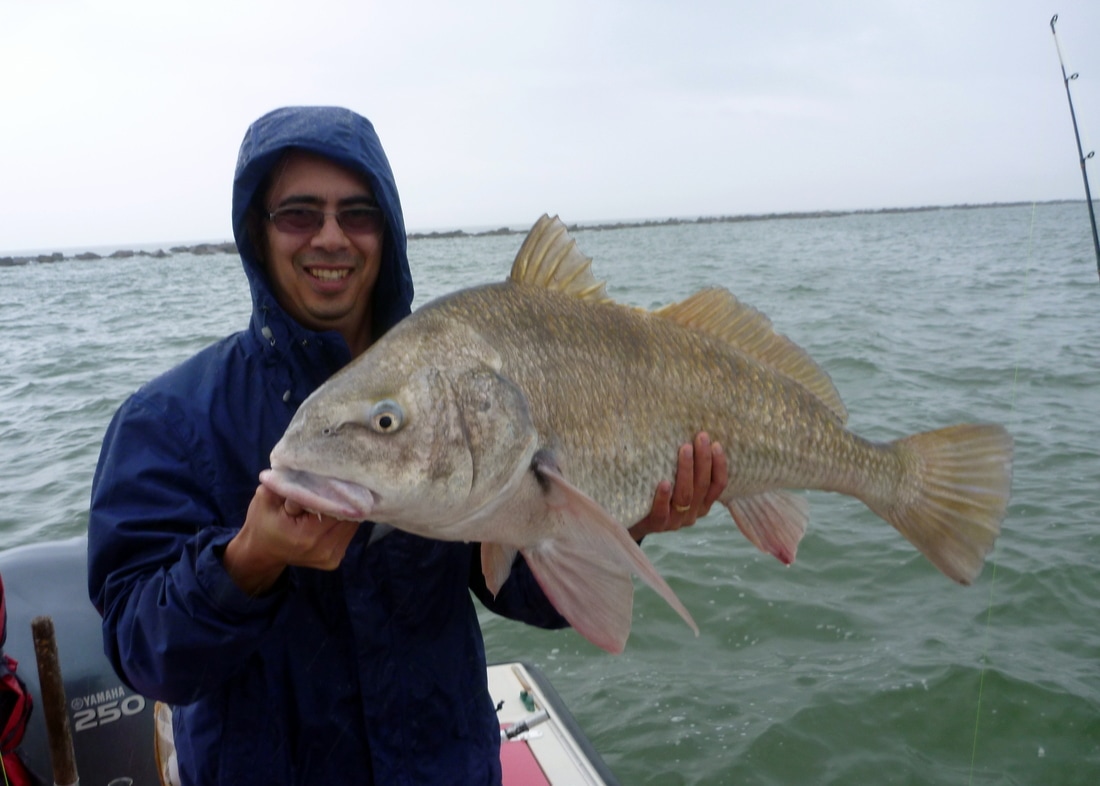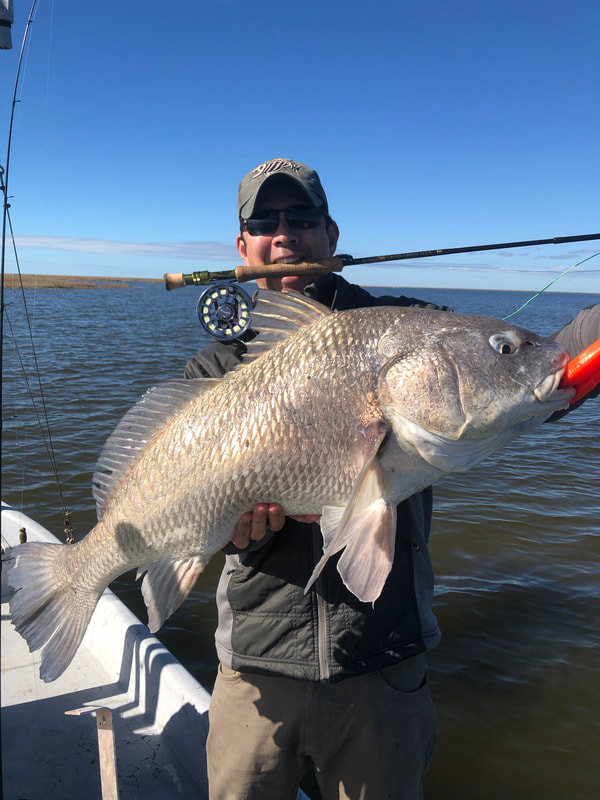Black Drum
Pogonias cromis
Home
Other Species
Black Drum Description
Black Drum are a nearshore fish found in many of the same areas as their cousins, the Redfish. They are spread throughout the western Atlantic and common in the Gulf states. As their appearance suggests, they primarily feed on the bottom and consume mollusks and crabs. Oysters are a favorite food, and oyster beds are a good place to locate these fish.
Black Drum can reach impressive sizes of over 100lbs, although most caught are 5-30lbs. Juveniles look quite different from adults, having black vertical bars that make them resemble Sheepshead. Like other drums and related fish, Black Drum make a loud drumming sound with their air bladder that can sometimes be heard outside the water. They are a robust fish, tolerating a wide variety of water temperatures and conditions.
Black Drum do not make sizzling runs or acrobatic jumps when hooked, but they put up a dogged fight.
Black Drum Pound for Pound Fight Rating - 4 out of 10 on the Saltwater Scale
Black Drum are not particularly strong on a pound for pound basis, but they do get pretty hefty so they can put up a pretty strong fight at the bigger sizes. They don't jump or make long runs; they just kind of bulldog near the bottom.
Black Drum Culinary Rating - Low
Large Black Drum are not very good to eat, and are hard to clean, but the small ones (under 5lbs) are ok. The skin has a fishy taste, so it is better to skin Black Drum than to try to remove the scales.
Black Drum Tackle
Black Drum tackle depends on the size of the fish targeted, but in general they do not run for cover when hooked and you can land some large ones on relatively light tackle. Although they have powerful jaws, they don't have sharp teeth so wire leaders are not needed. Click here for tackle recommendations.
Black Drum Techniques
Black Drum are found in many of the same areas as their cousins the Redfish. Although it is sometimes possible to catch them with lures, bait is much more productive since they primarily feed by smell. Black Drum often mouth baits before taking them, so wait until they start to move off with the bait before setting the hook.
Black Drum Baits
Crabs work well for bait, in particular a chunk of Blue Crab. Live or dead shrimp also work well especially for the smaller ones.
Black Drum Lures
A number of lures will work for Black Drum, including various plastics and flies. The key is to get them right in front of them and let them sit. They generally won't chase things very far. If you can sight fish them, you stand a decent chance of catching them on lures. If you can't see them, it can be tough since they won't move very far to eat generally.
Where to get the big Black Drum
All of the Gulf states have some big ones, but one of the premier places to target big ones is Galveston Bay in Texas. Much of the Louisiana coastline is good for them also.
Pogonias cromis
Home
Other Species
Black Drum Description
Black Drum are a nearshore fish found in many of the same areas as their cousins, the Redfish. They are spread throughout the western Atlantic and common in the Gulf states. As their appearance suggests, they primarily feed on the bottom and consume mollusks and crabs. Oysters are a favorite food, and oyster beds are a good place to locate these fish.
Black Drum can reach impressive sizes of over 100lbs, although most caught are 5-30lbs. Juveniles look quite different from adults, having black vertical bars that make them resemble Sheepshead. Like other drums and related fish, Black Drum make a loud drumming sound with their air bladder that can sometimes be heard outside the water. They are a robust fish, tolerating a wide variety of water temperatures and conditions.
Black Drum do not make sizzling runs or acrobatic jumps when hooked, but they put up a dogged fight.
Black Drum Pound for Pound Fight Rating - 4 out of 10 on the Saltwater Scale
Black Drum are not particularly strong on a pound for pound basis, but they do get pretty hefty so they can put up a pretty strong fight at the bigger sizes. They don't jump or make long runs; they just kind of bulldog near the bottom.
Black Drum Culinary Rating - Low
Large Black Drum are not very good to eat, and are hard to clean, but the small ones (under 5lbs) are ok. The skin has a fishy taste, so it is better to skin Black Drum than to try to remove the scales.
Black Drum Tackle
Black Drum tackle depends on the size of the fish targeted, but in general they do not run for cover when hooked and you can land some large ones on relatively light tackle. Although they have powerful jaws, they don't have sharp teeth so wire leaders are not needed. Click here for tackle recommendations.
Black Drum Techniques
Black Drum are found in many of the same areas as their cousins the Redfish. Although it is sometimes possible to catch them with lures, bait is much more productive since they primarily feed by smell. Black Drum often mouth baits before taking them, so wait until they start to move off with the bait before setting the hook.
Black Drum Baits
Crabs work well for bait, in particular a chunk of Blue Crab. Live or dead shrimp also work well especially for the smaller ones.
Black Drum Lures
A number of lures will work for Black Drum, including various plastics and flies. The key is to get them right in front of them and let them sit. They generally won't chase things very far. If you can sight fish them, you stand a decent chance of catching them on lures. If you can't see them, it can be tough since they won't move very far to eat generally.
Where to get the big Black Drum
All of the Gulf states have some big ones, but one of the premier places to target big ones is Galveston Bay in Texas. Much of the Louisiana coastline is good for them also.






